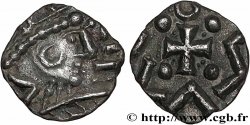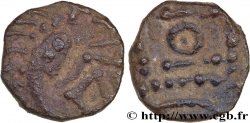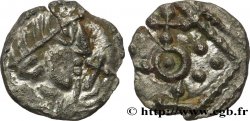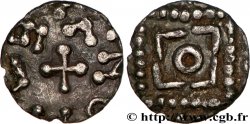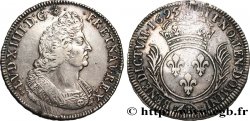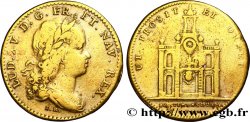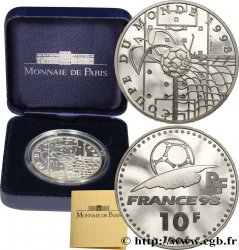недоступный.
Товар уже продан в нашем интернет-магазине (2010)
Цена: : 350.00 €
Товар уже продан в нашем интернет-магазине (2010)
Цена: : 350.00 €
Тип Sceat au porc-épic et à l’A croiseté
Дата: c. 695-740
Монетный двор / Город: atelier indéterminé
Металл: silver
Диаметр: 12,50 mm
Ориентация осей монеты: 9 h.
Вес: 0,46 g.
Редкость: UNIQUE
Комментарии о состоянии
Monnaie très légère sur un flan relativement large, mais très fin, comme dédoublé. Types centrés et presque complets, avec une agréable patine grise et irisée
Ссылки в каталоге: :
Происхождение:
Cet exemplaire est le n° 1674 de MONNAIES 41
Лицевая сторона
Аверс: легенда: ANÉPIGRAPHE.
Аверс: описание: Tête très stylisée à droite, composée d’un croissant vertical et des mèches de cheveux hirsutes en arrière ; une croisette en guise de visage.
Обратная сторона
Реверс: легенда: ANÉPIGRAPHE.
Реверс: Описание: Grand A croiseté, entre deux croisettes.
Комментарий
S’il est possible de reconnaitre une extrême simplification de types plus traditionnels au droit, le revers présente un A croiseté. Si le A croiseté est assez largement représenté dans le monnayage mérovingien, il est très rare dans le monnayage anglo-saxon (notons cependant la monnaie W100 reproduite par T. Abramson avec un A croiseté décrit comme un monogramme de Marseille et considéré comme un denier “anglo-merovingien” de la série W).
S’agit-il d’une frappe mérovingienne s’inspirant d’un sceat. Faut-il rappeler que les sceat circulaient largement dans toute la Gaule ? Ou alors s’agit-il d’un sceat reprenant un type de revers typiquement mérovingien ?
Quoi qu’il en soit, ce denier ou sceat semble manquer à toutes les publications sur le sujet.
While it is possible to recognize an extreme simplification of more traditional types on the obverse, the reverse presents a crossed A. While the crossed A is quite widely represented in Merovingian coinage, it is very rare in Anglo-Saxon coinage (note, however, the W100 coin reproduced by T. Abramson with a crossed A described as a monogram of Marseille and considered an “Anglo-Merovingian” denarius from the W series). Is this a Merovingian strike inspired by a sceat? Should we recall that sceat circulated widely throughout Gaul? Or is it a sceat reproducing a typically Merovingian reverse type? In any case, this denarius or sceat seems to be missing from all publications on the subject
S’agit-il d’une frappe mérovingienne s’inspirant d’un sceat. Faut-il rappeler que les sceat circulaient largement dans toute la Gaule ? Ou alors s’agit-il d’un sceat reprenant un type de revers typiquement mérovingien ?
Quoi qu’il en soit, ce denier ou sceat semble manquer à toutes les publications sur le sujet.
While it is possible to recognize an extreme simplification of more traditional types on the obverse, the reverse presents a crossed A. While the crossed A is quite widely represented in Merovingian coinage, it is very rare in Anglo-Saxon coinage (note, however, the W100 coin reproduced by T. Abramson with a crossed A described as a monogram of Marseille and considered an “Anglo-Merovingian” denarius from the W series). Is this a Merovingian strike inspired by a sceat? Should we recall that sceat circulated widely throughout Gaul? Or is it a sceat reproducing a typically Merovingian reverse type? In any case, this denarius or sceat seems to be missing from all publications on the subject








 Cообщить об ошибке
Cообщить об ошибке Распечатать страницу
Распечатать страницу Отправить мой выбор
Отправить мой выбор Задать вопрос
Задать вопрос Consign / sell
Consign / sell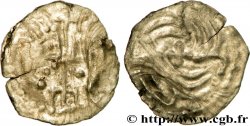
 Информация
Информация